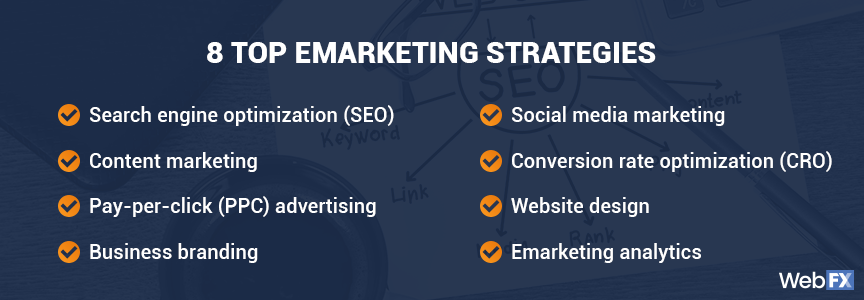8 Emarketing Strategies to Invigorate Online Presence
When it comes to emarketing, there’s a lot to talk about — like what strategies emarketing includes and how each will benefit your company.
On this page, we’ll talk about eight emarketing strategies that are sure to take your business to the next level, how to craft the perfect emarketing campaign, and more. If you’d like to learn more about emarketing, keep reading! To talk to an emarketing professional directly, give us a call at 888-601-5359.
Digital vs. Traditional Marketing
Download this guide to understand the key advantages, costs, and opportunities for each to decide which is best for your marketing strategy!
Get My Free Guide
8 top emarketing strategies and how to apply them

Top emarketing strategies include:
- Search engine optimization (SEO)
- Content marketing
- Pay-per-click (PPC) advertising
- Business branding
- Social media marketing
- Conversion rate optimization
- Website design
- Emarketing analytics
Using the emarketing strategies in this list will equip you to beat out competitors and earn more leads and revenue.
Every Internet marketing strategy has a different purpose and application to help improve your business online. Let’s get started by talking about a few of the most important marketing strategies for websites and how you can apply them to your own business.
1. Search engine optimization (SEO)
When we’re talking about emarketing strategies, one of the most important to note is search engine optimization (SEO).
SEO can help you reach your target audience and beat out competitors in search results, which leads to more sales, customers, and revenue. The main goal of SEO is to help your website rank higher in search since 33% of clicks go to the top-ranking result.
There are tons of micro-strategies associated with SEO that make it so effective, including keyword research, backlinking, user experience, and more.
Here are the most important micro-strategies associated with SEO and how you can apply them to your business strategy to improve your site’s ranking in search engine results pages.

How you can apply SEO to your company’s emarketing strategy
Here are a few micro-strategies to include in your overall internet marketing strategy to facilitate successful SEO:
- Keyword research: Keyword research allows you to determine exactly what your target audience is searching for online. These terms act as trigger words — so when users type a term related to your business into Google, it triggers results that best match that search.To be sure that you rank for these target keywords, keyword research is crucial to the SEO process. When you research keywords for your industry, you’ll be able to tell how hard it is to rank for them, how popular they are, and other important metrics.
- Internal linking: Internal linking ensures that all of your site pages are interconnected. Not only does this help site visitors easily find pages related to ones they’re already reading, but it helps Google find new pages on your site.
- Page speed optimziation: Making sure your site pages load quickly is a crucial part of creating a great user experience. Users want information in less than three seconds, and if it takes longer than that, you risk losing visitors to a competitor’s site.
These are just a few of the necessary SEO services that you’ll want to implement to ensure your site ranks highly in search. For a full list of SEO strategies offered by WebFX, check out our SEO services page!
2. Content marketing
When it comes to the best marketing strategies for websites, content marketing is at the top of the list. Without fantastic content, Google won’t be able to rank your website, and that means users will have a hard time finding your site at all.
Content is the perfect place to implement the target keywords that you come up with after performing keyword research. As a rule of thumb, you should base your content on your target keywords since your content is a great way to inform site visitors about your brand, what you do, and your products and services.
Not only that, but the more content you have, the more opportunities you have to rank in Google.
How you can apply content marketing to your company’s emarketing strategy
Here’s a step-by-step process to help your company implement a content marketing strategy:
- Brainstorm what it is your audience is interested in related to your offerings. Are they likely interested in learning more about your products and services? How your products work? How your products are made? Do they want to know related information like the benefits of using your products?After brainstorming the interests of your target audience (which you can also accomplish with keyword research), you’re ready to create content.
- Create different kinds of content. For example, there are far more options than just creating an article page for your website. Try starting a blog for your brand or videos that speak to your products and services.Users like variety and providing them with a variety of content not only makes them happy but gives you more opportunities to rank in search.
- Create content on a regular basis, and “double-dip” by utilizing it on various platforms. For example, you could share the most recent blog post in your next email newsletter, or share your latest article page on social media.
3. Pay-per-click (PPC) advertising
Pay-per-click (PPC) advertising is a strategy that you should consider for any website marketing plan. Not only does it help you gain site visitors, but it also helps you sell more of your products and services.
This strategy is exactly what it sounds like — advertising that allows you to pay as you go. PPC allows you to advertise in search engines, on social media platforms, and on websites across the web — and you’ll only pay when people click your ads.
Not paying for ad space and simply paying every time a user clicks your ad makes pay-per-click advertising one of the most cost-efficient emarketing strategies out there.

How you can apply pay-per-click ads to your company’s emarketing strategy
Here’s how you can get started with PPC ads for your company:
- Use the keywords you collected for your content strategy and repurpose them for ads. These keywords outline what users are searching for, which means they’re also great terms to use for your ads. Your ads are similar to your content in the way that they’ll appear when users search for a term that you target with one of your ads.
- Create ads that speak to customers’ wants and needs. When you opt for PPC ads, you’ll be able to design your ad in terms of appearance and text. Brainstorm the best ways to utilize your keywords in your ad copy as well as choosing an image that entices users to click.
- Design a landing page for when users click your ad so that they have the opportunity to convert right then and there. A landing page is where users arrive after they’ve clicked an ad, and it should provide them with an opportunity (or two) to convert.
4. Business branding
What makes business branding a key emarketing strategy?
Your company’s branding sets you apart from competitors. For example, if you work in the women’s clothing industry, you can set yourself apart by associating your business with a certain color scheme, font, or object in your logo.
All of these elements work together to set you apart in the minds of consumers, and even help make your brand a household name.
Without creating a unique brand that sets you apart, it’s harder to make a name for yourself in your industry.
For example, Insomnia Cookies, a cookie delivery service, has a logo that speaks to their brand. Not only does it feature a half-eaten chocolate chip cookie, but it displays the cookie as the moon — further speaking to the concept of late-night cookie cravings.

Not only does branding involve creating a great logo and color scheme for your business, though. You’ll also have to come up with a creative way to display the unique selling points (USPs) that no other competitors offer.
Providing users with insight into what makes your company truly unique also speaks to your branding.
When it comes to Insomnia Cookies, they gain customers not only by being one of the only cookie delivery services, but by delivering the cookies warm, and into the early morning hours.
How you can apply business branding to your company’s emarketing strategy
To apply business branding as an Internet marketing strategy, you’ll need to think long and hard about what your company stands for and who you want to attract. Follow these steps to facilitate unique business branding:
- Consider what makes your brand unique, and brainstorm objects, animals, and words that evoke your inimitable qualities as a business. For example, if your business provides access to over 100 different coffee beans, the number “100” might be significant in your branding. On the other hand, if your business is a non-profit that benefits polar bears, a polar bear might be a significant element of your logo.
- Consider your audience and their reaction to different kinds of branding. If your audience is mostly 20-somethings looking to decorate their first apartment, consider brand elements that would speak to their vivacity and excitement about their first space. You could evoke this excitement through the brand colors you choose, your logo, and more.
- Consider your brand’s most important unique selling points (USPs). Like we mentioned, creating your business branding is all about speaking to what makes your company unique. When creating your company’s branding, think about what you offer that no other brand offers. Your unique USPs could come into play with your logo, your tagline, or even your color scheme.
5. Social media marketing
With over 3.5 billion users taking advantage of everything that social media has to offer, it’s no surprise that social media marketing is one of the best emarketing strategies to adopt.
Not only does it offer a huge audience pool, but it’s also a great way to connect with your audience on a different level.
For example, when users site content, you’re connecting with them in a very general way. You’re likely not speaking directly to them, and it’s possible that users even have some questions about what they’re reading.

When you utilize social media marketing, most platforms offer a messaging feature that allows you to connect directly with your target audience. Direct messaging offers a way for customers to get ahold of you directly, but you can also create specific posts that speak to an ultra-specific portion of your target audience — providing another way for you to connect on a deeper level with your audience.
How you can apply social media marketing to your company’s emarketing strategy
Here’s how to get the most out of social media marketing for your company:
- Consider what platforms your audience uses most often. Are you targeting a younger audience that loves Snapchat? Or do you want to reach an older demographic that operates on Facebook? Considering these important demographic questions can help you decide what platforms you want to focus on when creating your social media strategy.
- Determine whether or not you want to use paid ads on your selected social media channels. Ads can be a great way to further target your ideal audience on social media.
- Repurpose your site content by sharing it as posts on your social platforms. Not only does this help build brand awareness on social media, but it also helps increase site traffic by guiding users back to your site.
6. Conversion rate optimization (CRO)
In terms of emarketing techniques, conversion rate optimization (CRO) is extremely important to the overall success of your internet marketing strategy.
The use of CRO helps you tailor site content and marketing materials in order to boost conversions. In other words, CRO encourages more people to purchase your products and services, which leads to increased revenue year over year.
CRO services ensure that your website is in tip-top shape for conversion, analyzes copy, and helps you determine where you can improve your site to increase conversions.
CRO is also crucial for your paid ads and landing pages to ensure that they’re performing efficiently and effectively.

How you can apply CRO to your company’s emarketing strategy
Check out the ways you can implement CRO to ensure a successful emarketing strategy:
- Determine what areas of your website or current marketing strategy that you want to test. Test areas typically include things like call-to-action (CTA) buttons on your site, quote forms, and even your content. You should also consider CRO for your paid ad strategy to determine if your ads and landing pages are effective.
- Think about your goals as a company, and if you don’t have any, create goals based on your current conversion rate. Are you happy with your conversion rate? If not, set a goal for where you’d like to be after implementing CRO.
7. Website design
Your website design is a crucial part of your website marketing plan because it’s technically your brand’s home. It’s where you’re able to store all of your content, product and service pricing and descriptions, contact forms, and so much more.
Without a knock-out website, it’ll be hard to build an Internet marketing strategy that works.
Your website’s design should speak to your brand and follow all of your brand identity guidelines. It should speak to your brand and exude your message, goals, and focus.
When users come to your website, it’s typically their first impression of your brand, so your design must be spot-on.

How you can apply web design to your company’s emarketing strategy
There are a lot of things to think about when it comes to web design! Here are a few things to keep in mind when implementing web design as an emarketing technique:
- Give your web designer guidelines based on your brand and let them know what you like and dislike. Giving this information upfront will ensure that you get a final product that you’re satisfied with.
- Be sure that your website is responsive. Without a responsive design, users that surf your site on a tablet or smartphone won’t get the same experience as those surfing on a desktop. Without a responsive design, it also makes it hard for smartphone users to click your buttons or use your forms.
- Make sure that your site has an effective navigation bar. Users get overwhelmed if you create a nav bar that is too large or has too many options. Start with the basics and provide a general drop-down menu for broad categories. An organized nav bar helps users find what they’re looking for quickly and easily and will keep them from bouncing to a competitor’s site.
8. Emarketing analytics
If you want to make sure your emarketing techniques aren’t in vain, you’ll want to analyze just how well they’re working.
Without marketing analytics, you won’t be able to determine areas of improvement on your website, and therefore, won’t be able to make the most of your online presence.
To ensure that your marketing strategies are working to the best of their ability, it’s crucial that you analyze the results of each campaign.
You can do so by using programs like Google Analytics, in which you can set specific goals and keep track of important metrics like site traffic, bounce rate, and so much more.
How you can apply emarketing analytics into your company’s emarketing strategy
It’s simple and easy to analyze your website’s success when you use Google Analytics:
- Determine your company’s most important metrics. If you’re an ecommerce store, one of your most important metrics will be online sales. If you have both an online store and brick and mortar store, one of your most important metrics will be site traffic. Thinking about the metrics that mean the most to your specific business will help you keep track of your site’s performance in the most important areas.
- Give your website time to perform. You won’t gain anything from looking at your analytics a week after you’ve started tracking your site’s progress. You’ll want to be sure to give your site a long enough test period to collect data that will be helpful. A few months of data is typically enough to start drawing conclusions.
- If any of the metrics are lower than anticipated, you can start improving your site in the areas that affect those metrics. For example, if your site traffic isn’t high enough, you know that it’s time to put a little extra time and effort into your SEO campaign.
Get started with emarketing strategies from an agency you can trust!
If all of these emarketing techniques sound like great additions to your current website marketing company plan, or if you’re starting from scratch, WebFX can help.
We’ve been in business for over two decades, and we take pride in helping our clients succeed with our emarketing strategies. We know that no two businesses are the same, which is why all of our campaigns are custom depending on your unique needs.
We work with a variety of clients in an array of industries from loan officers to radio stations.
We provide all of the emarketing strategies you’ve read about on this page in addition to tons of other strategies that can make your online presence soar. Speaking of online presence, our website design team has won more than 50 awards for their stellar web designs, and they can’t wait to create yours!
We also have over 1,100 testimonials that speak to our customer satisfaction over the years.
If you’d like to get started with your custom emarketing campaign, WebFX is ready to partner with you. You can contact us online, or if you’d like to speak with a specialist, you can give us a call at 888-601-5359.
Digital vs. Traditional Marketing
Download this guide to understand the key advantages, costs, and opportunities for each to decide which is best for your marketing strategy!
Get My Free Guide
Related Resources
- 7 Digital Marketing Strategies for Franchises
- 7 Ways to Get More Reviews for Your Business
- 7+ Digital Marketing Solutions for Growing Your Business
- 8 Digital Marketing Strategies for Your Campaign
- 8 Expert Digital Marketing Optimization Tips to Follow
- 8 Fresh Marketing Ideas for Small Businesses
- 8 WordPress CRM Plugins to Manage Your Customers Better
- 9 Niche Marketing Examples
- 9 Types of Digital Marketing Crucial to Your Business’s Success
- Data-Driven Marketing: How to Leverage First-Party Data to Drive Marketing Results
Marketing Tips for Niche Industries
- 7 Optometrist Marketing Strategies to Attract Patients
- 7 Reasons Why You Need Ecommerce for Industrial Products
- 7 Ways to Market Your Brewery Online
- 70+ Retail Statistics Marketers Should Know in 2024
- 8 Finance Industry Trends to Know and Follow in 2024
- 8 Health Insurance Marketing Ideas to Drive Up Your Revenue
- 8 Lead-Driving B2G Marketing Strategies: Which Will You Use?
- 8 Orthopedic Marketing Strategies for Every Practice
- 8 Tech Industry Trends to Watch out for in 2024
- Best Manufacturing Marketing Agencies









